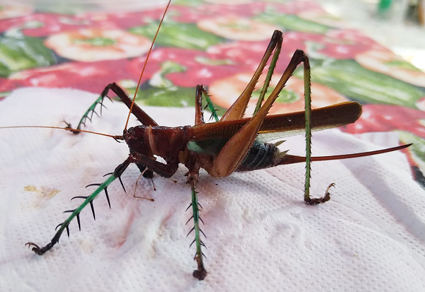Abstract
The genus Listroscelis is part of Listroscelidini (Tettigoniidae: Listroscelidinae) and comprises 11 species of predatory katydids only known from Brazil. Currently, the group’s greatest richness is recorded in the Atlantic Forest biome. In this work, the new species Listroscelis cyanotibiatus sp. nov. is described to the Northeastern Atlantic Forest biome. Morphological characters of both sexes and the male internal genitalia are described. A distribution map of the species and comments on its natural history are provided.
References
Bruner, L. (1915) Notes on tropical American Tettigonoidea (Locustodea). In: Holland, J.W. (Ed.), Annals of the Carnegie Museum. Vol. IX. Carnegie, Pittsburgh, pp. 284–404 https://doi.org/10.5962/p.35280
Chamorro-Rengifo, J. & Lopes-Andrade, C. (2014) The phallus in Tettigoniidae (Insecta: Orthoptera: Ensifera): revision ofmorphology and terminology, and discussion on its taxonomic importance and evolution, Zootaxa, 3815 (2), 151–199. https://doi.org/10.11646/zootaxa.3815.2.1
Cigliano, M.M., Braun, H., Eades, D.C. &Otte, D. (2010) Orthoptera Species File. Version 5.0/5.0. Available from: http://Orthoptera.SpeciesFile.org (accessed 22 May 2022)
Desutter-Grandcolas, L. (2003) Phylogeny and the evolution of acoustic communication in extant Ensifera (Insecta, Orthoptera). Zoologica Scripta, 32 (6), 525–561. https://doi.org/10.1046/j.1463-6409.2003.00142.x
Dias, P., Rafael, J.A. & Naskrecki, P. (2012) A taxonomic revision of the Neotropical genus Aegimia Stål, 1874 (Orthoptera, Tettigoniidae, Phaneropterinae). Journal of Orthoptera Research, 21 (1), 109–132. https://doi.org/10.1665/034.021.0108
Fialho, V.S., Chamorro-Rengifo, J., Lopes-Andrade, C. &Yotoko, K. (2014) Systematics of spiny predatory katydids (Tettigoniidae: Listroscelidinae) from the Brazilian atlantic forest based on morphology and molecular data. PLoS ONE, 9 (8), 1–42. https://doi.org/10.1371/journal.pone.0103758
Karny, H. (1911) Descriptions Conocephalidarumnovarum. Verhandlungen der Zoologisch-Botanischen Gesellschaft in Wien, 61, 334–347.
Krauss, H.A. (1902) Die Namen der ältestenDermapteren- (Orthopteren-) Gattungen und ihreVerwendung für Familien- undUnterfamilien-Benennungen auf Grund der jetzigenNomenclaturregeln. ZoologischerAnzeiger, 25, 530–543.
Mello-Leitão, C. (1940) Quatro novosTetigonioides do Brasil (Orthoptera). Revista de Entomologia, 11, 150–162.
Mendes, D.M.M., Chamorro-Rengifo, J. & Rafael, J.A. (2016). A new genus of predatory katydids (Orthoptera: Tettigoniidae: Listroscelidinae) from the Amazonian Rainforest. Zootaxa, 4162 (3), 594–600. https://doi.org/10.11646/zootaxa.4162.3.12
Perty, M. (1833) Delectus animaliumarticulatorum: quae in itinere per Brasiliam annis MDCCCXVII–MDCCCXX jussu et auspiciisMaximilianiJosephi I. Bavariaeregisaugustissimiperactocollegerunt Dr. J.B. de Sphix et Dr. C.F. Ph. De Martius. ImpensisEditoris, Munich, ii + 224 pp.
Redtenbacher, J. (1891) Monographie der Conocephaliden. Verhandlungen der KaiserlichKoniglichenZoologischBotanischen Gesellschaft in Wien, 41, 315–562.
Serville, J.G.A. (1831) Revue méthodiquedesInsectes de l’ordredesOrthoptères. Annales des Sciences Naturelles, 22, 28–65.
Shorthouse, D.P. (2010) SimpleMappr, an online tool to produce publication-quality point maps. Available from: http://www.simplemappr.net (accessed 25 January 2020)
Walker, F. (1869) Catalogue of the Specimens of Dermaptera Saltatoria in the Collection of the British Museum. BritishMuseum, London, 157 pp.


